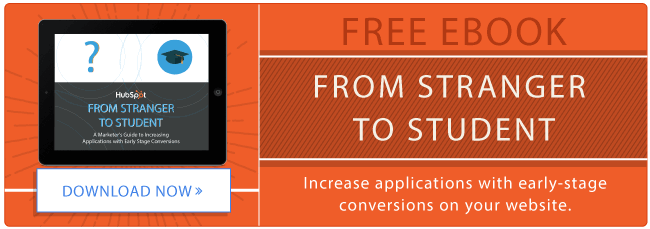
You have traffic and lead generation campaigns that are filling up your database. Your cup runneth over. It's time to make sure that your best prospects aren't the ones falling by the wayside. You need a lead nurturing program that helps you identify the prospects who best fill your ideal student persona and focus your efforts on them.
The crux of the inbound methodology is getting the right message to the right people at the right time. But your team doesn't have the time to pick out the right piece of content, at the precise magic moment, for each individual prospect in your database that will move them further along their enrollment journey. There's no point in sending an invitation to meet with an admissions counselor to a rising junior prospect who just downloaded your free study tips guide. That's worse than wasted effort! Your school will look unorganized to this prospect — not the impression you want to make.
Instead, use automated email workflows to nurture prospects into enrolled students by send the most relevant information at each stage of the enrollment journey. Automation amplifies the productivity of your team and your database. Too much gets overlooked when you rely on manual nurturing.
Here's a step-by-step breakdown of how to design and execute an amazing student-nurturing workflow.
1) Have a Goal in Mind
Actually, you need two goals. First, define what your objective is for the workflow. Let's say you need to boost enrollment in the next two dental assistant program enrollment cycles. You're running live, on-campus information sessions targeting your January and June enrollment dates. You can put together a nurture workflow with the goal of getting quality prospects to attend one of these sessions.
Then, you need a Goal List. How many people do you need to attend these sessions to translate into the right number of applications and enrollments? That's your Goal List — the list of prospects who entered this workflow and took the action you wanted. In our example, it's the number of people who attended an information session.
2) Identify your Starting Criteria
Create a smart list that scoops up prospects who meet the specific criteria that make them good candidates for this workflow's goal. Think about criteria about who they are right now, where they are in their school decision journey, and what sort of action they've taken. No broad strokes here.
So a list of people interested in your dental assistant program who mostly access your content via mobile device is too vague. Start with that criteria, but add: lives within 25 miles of one of your campuses offering your dental assistant program.
In short: Be specific!!
3) Map it Out
Truly — write this out by hand to get the flow right. Include three data points per spot on your workflow map:
- What content you're sending them — make sure it aligns with where they are
- The goal for that specific piece of content
- Day delay count — this is the number of days between each email in the workflow (aka the "cadence")
Using our current example, we know that these potential students are in the consideration phase, looking to short-list the schools they want to apply to. The goal of the workflow is to get them to attend your live, in-person information session on campus. So the workflow map could be:
- Trigger: Lead who meets the criteria "downloads the program's admission requirements checklist."
- Delay 5 days: send email with link to your Facebook post of a video message from current dental assistant students. The goal of this email is to personalize your program and help prospects see who their peers could be.
- Delay 3 days: send email with a link to download your report on the various types of dental positions this program prepares its graduates for. This email's goal is to put in real terms exactly how your program prepares them for a career.
- Delay 5 days: send them a link to blog post of your dental program's FAQs. This content is prep work so they can clarify the bigger questions they'll want to ask in person.
- Delay 2 days: send email invitation to attend a live information session, mentioning this is where they'll learn about program selection criteria, types of practicums available, and have opportunity to meet current students and admissions officers.
4) Write your Emails!
Keep all these data points in mind to write clear, focused, single call-to-action (CTA) emails. You can also use the email copy to tease or set up the next email. Your email with the link to the program FAQ can frame it as the source to get answers for the most common questions, while your invitation email promotes the session as the opportunity to get their personal questions addressed.
For more on email, check out our free ebook Email Marketing for Schools >>
5) Decide on an Exclusions Policy
Refine your workflow here. Exclusions can be not sending on emails on Fridays, because you know you get nearly zero engagement on those emails.
You can also create suppression lists of people who meet this workflow's criteria, but you don't want included in it. This could be people who've already submitted an application. You want them in a different workflow that invites them for an admissions interview.
In fact, another suppression list can be anyone who's currently in another active workflow. You don't want to inundate prospects with too many emails at once. Let their current workflow play out. You'll have more info on them to divert them into the most applicable workflow once it's done.
6) Turn the Workflow on!
That was an easy step...
7) Measure and Improve
Always be analyzing. Look at your results to see where you need to improve or tweak things. Your top-level metrics are the number of people who enter this workflow, the number who reach your Goal List, and the workflow's conversion rate (prospects in workflow divided by those who took goal action = conversion percentage).
Take a closer look at low performing emails to find out why people aren't opening or taking action.
Why Marketing Automation?
Email is easy and inexpensive. It's one of the best tools in your arsenal made more effective with automated, smart workflows. Automating email lead nurture campaigns optimizes your database and your marketing efforts by making sure your best prospects don't get ignored, which translates into more quality applications, and higher enrollment numbers.
from HubSpot Marketing Blog http://blog.hubspot.com/marketing/steps-to-building-an-amazing-student-nurturing-workflow

No comments:
Post a Comment